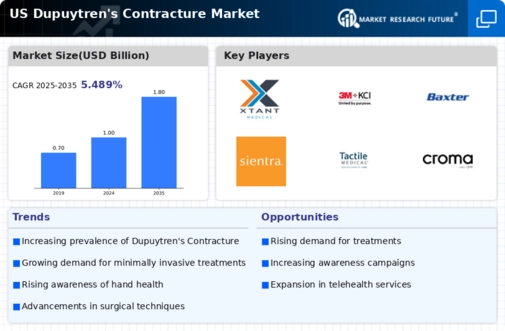The US Dupuytren's Contracture Market is characterized by a mix of established players and emerging companies that are competing to provide effective treatments for this hand condition. Dupuytren's Contracture, characterized by the thickening and shortening of the palmar fascia, leads to considerable hand function impairment. As such, the market has seen significant innovation and investment aimed at developing minimally invasive procedures, drugs, and surgical interventions. With a growing awareness of the condition and advancements in treatment modalities, the environment is conducive to competitive activities with many companies investing in research and development to capture market share.
Factors influencing competition include product efficacy, safety profiles, regulatory approvals, and distribution networks, which play a crucial role in shaping the market landscape.
Xtant Medical has established a significant presence in the US Dupuytren's Contracture Market, leveraging its robust portfolio of medical devices designed for orthopedic applications, including soft tissue repair. The company has distinguished itself through its high-quality products and commitment to innovative solutions that enhance surgical outcomes. By focusing on research and development, Xtant Medical aims to stay ahead of market trends and address unmet clinical needs.
The strength of Xtant Medical lies in its strategic partnerships with healthcare providers and a strong distribution network, which enables the company to enhance its visibility and availability of its products in various healthcare settings across the United States. The company's focus on leveraging technology and improving surgical techniques is expected to continue contributing to its competitive edge.
Merz Pharmaceuticals holds a notable position in the US Dupuytren's Contracture Market with its well-established product portfolio that includes Collagenase Clostridium Histolyticum, specifically designed for the non-surgical treatment of this condition. The company's presence is bolstered by a dedicated marketing strategy focused on raising awareness among healthcare professionals and patients alike about the benefits of early intervention. Merz Pharmaceuticals has demonstrated strength in maintaining a technologically advanced approach, ensuring that products meet regulatory standards while effectively addressing the needs of patients.
Mergers and acquisitions have also played a significant role in enhancing the company's capabilities and expanding its product offerings, thereby enabling Merz Pharmaceuticals to solidify its footprint in the US market for Dupuytren's Contracture. The collaboration with key stakeholders, including medical experts and institutions, further supports the company's growth strategy and enhances its competitive position within the market.






















Leave a Comment